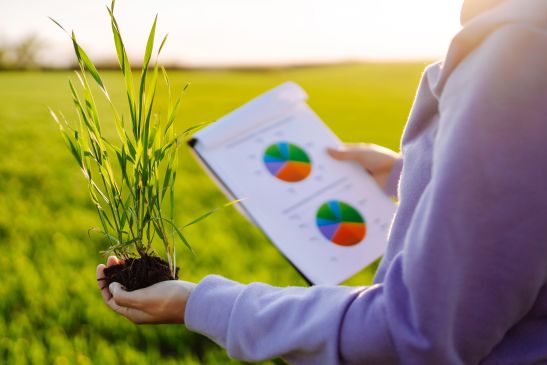Crisis benefits us in that it is pushing us toward change. In the current uncertain times of disrupted supply chains, high input and labor costs, ongoing climate changes, and increasing geopolitical changes, the agriculture industry is facing a perfect storm. And while some farmers struggle to keep things the way they are, others turn to new ag practices and technologies to optimize returns and mitigate risks.
Data-driven technologies for the food value chain
Despite recent ease in fertilizer and fuel prices, the costs of crop protection agents, animal feed, labor, and business operating expenses remain steady-high, putting pressure on producers. Experts say the current economic environment is fueling the adoption of agtech, especially among large agribusinesses.
The combination of farm management software and precision ag hardware is seen as a win-win for optimized input use. While the first is able to provide necessary data for calculating variable rates of seeds, fertilizer, and pesticide applications, the latter can prevent their under- or overuse.
By applying the right amounts of nutrients and crop protection agents, growers can get the best of both worlds: cut down on expensive input costs and avoid major causes and consequences of decreased soil fertility, which directly affects field productivity and crop yield.
Another major factor encouraging farmers to integrate modern technology into their farming routines is the sustainability trend. Globally, food consumers have been increasingly opting for sustainable food products, aiming to reduce the negative environmental impact of food production.
And agritech market responds to the rising demand by offering low-emission farming machinery, satellite monitoring and yield mapping software, variable rate application technology, and other sustainability-focused solutions. They target all aspects of crop production – crop, soil fertility, and water management to name a few – helping farmers reach sustainability goals and preserve our capacity to continue indefinitely within the planet’s ecosystems.
EOSDA Crop Monitoring – satellite technology aiding in soil fertility tracking
Arable land depletion is one of the pain points of today’s global agriculture that food producers need to deal with. Heavy plowing and fertilizer use combined have led to massive soil degradation that cannot be compensated for by natural restoration. Technology can provide farmers with the necessary support in their transition to more sustainable practices that help maintain fertile soil perfect for growing crops.
By utilizing precision agriculture software like EOSDA Crop Monitoring by EOS Data Analytics, crop growers get valuable insights that enable better soil fertility management decisions. The platform can be used to create satellite data-derived productivity maps that break a field into zones based on their productivity across several years.
As a result, field owners can focus on low-yielding plots, adjusting input applications and enhancing the soil sampling efficiency. Additionally, the platform allows storing years’ worth of data on crop rotation – one of the most effective ways to improve soil fertility. This is especially useful for large farms owning huge cropland areas.
Custom approach to solving growers’ tasks and maximizing their profits
On top of out-of-the-box solutions, the agtech industry has seen the emergence of custom services that offer advanced ways to meet agribusiness goals. EOS Data Analytics harnesses the combined power of satellite imagery, Big Data processing, and artificial intelligence to detect field boundaries, predict crop yield, monitor harvest dynamics, and run advanced soil moisture analysis and crop classification within the scope of the client’s request.
Crop yield estimation can become an essential part of crop management strategy development for a field, region, or even a country. EOSDA delivers up to 90%-accurate forecast of crop yield based on the previous seasons’ statistics and trends. In case of negative prediction, agricultural producers can step in and decide how to increase soil fertility to improve future yields and profits.
Digital vs. conventional agriculture: comparing the payback period
The undeniable benefits of digital ag technologies like EOSDA Crop Monitoring include optimization of farm operations, cost reduction, yield and profit maximization, and reduced environmental footprint. But how fast do these investments pay back?
The fear of investing in ‘the unknown’ – hi-tech novelties – and never making this money back is one of the main factors hampering agricultural technology adoption. Most farmers still prefer investing in the ‘good old’ mechanization and irrigation over modern software, even though such investments usually take 6–7 years to pay off.
The payback period for digital software, on the other hand, is 1–2 years, which means that there is a strong chance that the positive results of farm digitalization might be seen after one growing season.
And there’s even more value to digitalization. Not only does it solve farmers’ problems, but data-driven technologies also help measure progress all along the way. Tracking agronomic performance, such as crop and soil health, field operations, input amounts, etc., provides current (in-season) progress that can be correlated back to crop yields and enables long-term analysis of the decisions made.
Future outlook
Booming technological innovations alongside steady-high global food price inflation are the major factors pushing agricultural producers toward the adoption of digital agtech. By investing in smart digital solutions like farm management software, they stand a better chance of maximizing their returns and minimizing production costs through more efficient resource use.
As the agricultural landscape shrinks due to poor soil management practices and irresponsible fertilizer use, sustainable farming practices become an urgent necessity. Digital agricultural solutions can provide farmers with actionable insights into their crops and fields, helping increase the output while reducing the environmental footprint and maintaining soil fertility.





